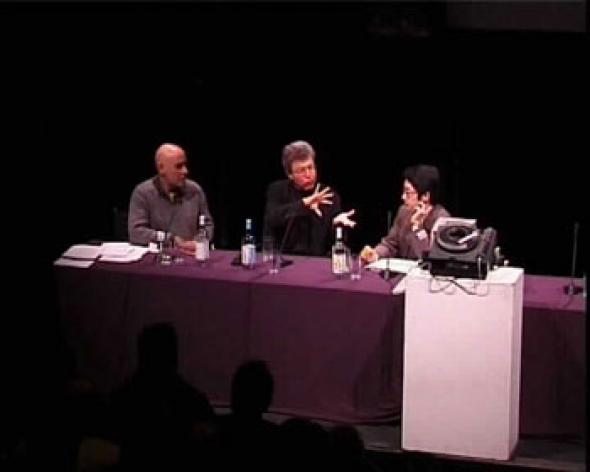That Old Cartesian Grid
When a conference on technology gets stuck in the mire of dubious oppositions from the outset, how far can it go? Not very far, argues David Panos.
The ICA’s Inhabiting Technology conference, held on the eleventh and twelfth of March, hosted a mixed bag of theorists and practitioners culled from a diverse array of disciplines. Heavyweight praxis from überarchitects Daniel Liebeskind and Rem Koolhaas, deft cultural criticism from Akira Asada and the trans-historical net semiology of Lev Manovich sat alongside clinical neurophysiology from Detlef Linke and the genteel academicism of Cambridge anthropologist Marilyn Strathern (highly refreshing after excruciating post-coherent PoMo histrionics from self-confessed ‘Dirty Theorist’ johnny de philo (sic) and the uncritical interjections of junior lecturers with all the sycophantic flair of airline hostesses).
The conference sessions were premised on a self-imposed dichotomy: to quote the conference agenda, "we persist in thinking of inhabiting…as a place or space and as static. And technology as…shifting, constantly in flux". The broad aim of the conference was to go some way towards resolving this conceptual gulf.
At first glance such a resolution would seem pertinent in an age where architects and artists as well as WAP-happy new media pros are having to accommodate themselves to the objectless world of the ‘new economy’. At the conference, Koolhaas announced a new division of his Office for Metropolitan Architecture set up to handle the increasing demand for non-corporeal practices, whilst Peter Weibel — ‘CEO’ of Germany’s ZKM, Centre for Art and Media — drew attention to the disappearance of the art object (and unwittingly, the vanishing distinction between net art and net commerce).
But was this ‘static/shifting’ distinction the soundest starting point for a critical inquiry into our present day circumstances? As Akira Asada observed in conversation with Daniel Liebeskind, thinking the old order of built architecture as static in comparison with the flux of ‘virtual’ or ‘interactive’ space deprecates our already active subjective relationship to the built environment. Asada claims that architectural space is "already virtual"; it makes you "feel and see something else" (the mnemonic gestures of Liebeskind’s work are a fine realisation of this) but the "pretty colours" of VR, once frozen, are "so boring". He seems to suggest that where the dialectic between consciousness and a ‘static’ object resolves itself through the evocation of something greater than the sum of its parts, the ever yielding ‘streams and flows’ of the virtual result in a non-engagement.
Asada’s point is critical when assessing many of the speakers at Inhabiting Technology. Those who had taken on the agenda of ‘interactivity’ most self-consciously appeared to found their work on painfully reductive, mechanistic notions of social, subjective and artistic processes. A session with Gloriana Davenport (Director of the Interactive Cinema Group at MIT’s Media Lab) and Stephen Mamber (from UCLA’s Film and Television School) was a case in point. Davenport is exploring the possibilities of interactive narrative, but uses soap opera story lines as her model, informing us that a "good narrative" presses "emotional buttons". Mamber’s digital reconstructions of cinematic narratives, supposedly a tool for study, rendered the complexity and dynamics at work in a Hitchcock film into bloodless bar charts and flow diagrams.
These attempts to transcend the ‘fixed’ authority of traditional narrative through the ‘two-way’ relationship inherent in interactive technology seem to beg the question posed by Akira Asada’s intervention. As technology forcibly liberates its audience into the position of author, does it not rob us of the truly critical space of reflection? The corollary of this misguided conception of narratives (and buildings) as ‘fixed’ and technology as ‘fluid’ is a pacifying instrumentalisation of conscious processes.
This instrumentality was chillingly apparent in Gloriana Davenport’s deployment of interactive narrative as a moral therapy for America’s prison population, teaching them how to ‘understand’ a victim’s point of view; or in ‘urban curator’ Raoul Bunschoten’s ‘collaborative’ projects where existing urban conditions are incorporated into planning projects but thereby co-opted and defused. Lev Manovich neatly demonstrated how the formal play and reflexivity of the modernist avant-garde is now built in to our everyday relationship to computers. One cannot switch on Windows without acknowledging a debt to the montage techniques of Dziga Vertov, or the visual atomism of Kandinsky. Strategies once deployed to shake audiences out of the hypnotic hallucination of bourgeois life have now become part of our integration into the hi-tech systems of post-industrial life.
Finally, it is telling that the conference returned again and again to Borges’s fable of a map that grows bigger than the territory it represents. More astonishing than the fact that a prime piece of 80s theory (Baudrillard cites the map in Simulations) should fuel a conference supposedly teetering on the cutting edge, was the fact that the participants seemed happy with the insight that the mapped world of signification might become equal or greater than its signified. However, glancing again at Simulations, Baudrillard astutely points out that "even inverted, the fable is useless" — it is pointless to talk of two separate terms when ‘reality’ and its ‘representations’ are thoroughly intertwined, ergo hyper reality. Where Inhabiting Technology failed was precisely in its inability to move critically beyond the (false) opposition that formed its premise. So many of the conference speakers, despite their progressive techno-discourse, simply reinforced the crude static/shifting dichotomy whilst the most enlightening and dynamic thinkers would not have entertained it in the first place.
David Panos <david AT senseworldwide.com>, <david AT year-zero.com>
Mute Books Orders
For Mute Books distribution contact Anagram Books
contact@anagrambooks.com
For online purchases visit anagrambooks.com








